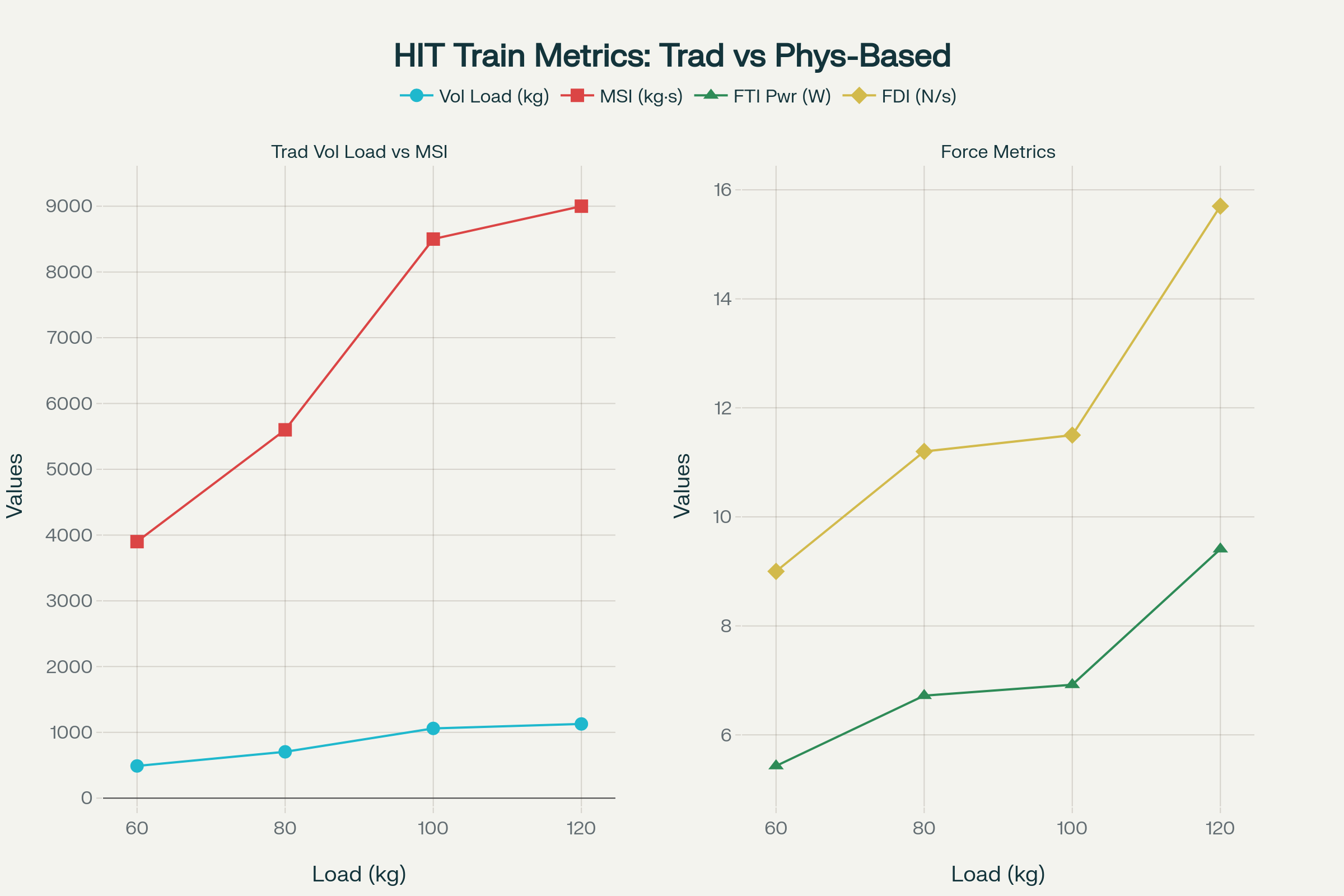High Intensity Training Force Metrics: Beyond Reps × Weight
/ 4 min read

High Intensity Training Force Metrics: Beyond Reps × Weight
Traditional strength training metrics like reps × weight fall short in capturing the essence of High Intensity Training (HIT), which emphasizes Time Under Load (TUL) and training to momentary muscular failure[^1][^2][^3]. To better understand and quantify the “total force as weight moved over time” in HIT, we need physics-based metrics that account for both force application and temporal factors.
The Physics Foundation
In HIT, the key principle is continuous movement under constant tension for 60-90 seconds until reaching momentary muscular failure[^1][^3]. This approach requires metrics that capture:
- Force: The actual force generated (Weight × 9.8 m/s²)
- Time: Duration of muscle tension (TUL)
- Work: Mechanical work performed (Force × Distance)
- Power: Rate of work done (Work ÷ Time)
The fundamental physics equations that apply to HIT training include[^4][^5]:
- $ F = ma $ (Force equals mass times acceleration)
- $ W = F \times d $ (Work equals force times distance)
- $ P = W/t $ (Power equals work divided by time)
- $ J = F \times t $ (Impulse equals force times time)
Proposed HIT Force Metrics
Based on the research and physics principles, here are five comprehensive metrics that better represent “total force”TI) - Power-Based Metric** $ FTI = \frac{Load \times g \times ROM}{TUL} $
Where:
- Load = Weight lifted (kg)
- g = 9.8 m/s² (gravitational acceleration)
- ROM = Range of motion (meters)
- TUL = Time under load (seconds)
- Units: Watts (J/s)
This metric represents the average mechanical power output during a HIT set, providing insight into the rate of energy expenditure[^6][^7].
2. Mechanical Stress Index (MSI) - Impulse-Based Metric $ MSI = Load \times TUL $
Units: kg·s (impulse units) This represents the total mechanical stress applied over time, similar to impulse in physics[^8][^9].
3. Force Density Index (FDI) - Force Application Rate $ FDI = \frac{Load \times g}{TUL} $
Units: N/s This measures the rate of force application, indicating how efficiently force is generated per unit time.
4. Work Capacity Index (WCI) - Total Mechanical Work $ WCI = Load \times g \times ROM \times Estimated Reps $
Units: Joules (J) This quantifies the total mechanical work performed during the set[^5][^10].
5. Tension-Time Product (TTP) - Relative Intensity × Duration $ TTP = \frac{Load}{Max Load} \times TUL \times 100 $
Units: % × seconds This represents the relative tension sustained over time, crucial for hypertrophy stimulus[^11][^12].

Side-by-side comparison of traditional volume load with physics-based HIT training metrics across different loading conditions
Advantages Over Traditional Metrics
These physics-based metrics offer several advantages over the simple reps × weight approach:
Temporal Integration: Unlike traditional volume load, these metrics incorporate the critical time component that defines HIT training[^1][^13]. Research shows that time under tension between 40-70 seconds is optimal for muscle hypertrophy[^14][^12][^15].
Force Application Precision: The metrics account for actual force generation (Weight × 9.8 m/s²) rather than just load magnitude, providing a more accurate representation of mechanical stress[^16][^17].
Power Considerations: The FTI metric specifically addresses power output, which is crucial for understanding training intensity and effectiveness[^6][^18]. Studies indicate that optimal power development occurs at specific load-velocity relationships[^19][^20].
Physiological Relevance: Research demonstrates that muscle hypertrophy and strength gains are better correlated with time under tension and mechanical stress than simple volume calculations[^21][^11][^15].
Practical Application
For a practical example, consider comparing two training sets:
Traditional Approach: 100kg × 8 reps = 800kg volume load HIT Approach: 100kg × 75s TUL = 7,500 MSI
The HIT metrics provide additional insights:
- FTI: 7.84W (assuming 0.6m ROM)
- FDI: 13.1 N/s
- WCI: 5,880J
- TTP: 5,000%·s (assuming 80% 1RM)
Implementation Strategy
To implement these metrics in HIT training:
- Track TUL precisely using a stopwatch from initiation to failure[^1][^22]
- Measure range of motion for each exercise to calculate work accurately
- Monitor progression through increasing MSI rather than just weight or reps
- Use FTI to compare power efficiency between sessions
- Apply TTP to ensure adequate stimulus intensity (40-60% for hypertrophy)[^3][^15]
Conclusion
The proposed force metrics provide a more scientifically grounded approach to understanding and quantifying training stimulus in HIT. By incorporating time, force, and work principles from physics, these metrics better capture the essence of “total force as weight moved over time” compared to traditional volume calculations. The Mechanical Stress Index (MSI) emerges as particularly practical for day-to-day training tracking, while the Force-Time Index (FTI) offers valuable insights into power development and training efficiency.
This framework allows practitioners to move beyond simple multiplication of reps and weight toward a more nuanced understanding of the mechanical and physiological demands of High Intensity Training, ultimately leading to more effective program design and progression strategies.